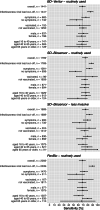Detection of SARS-CoV-2 infection in the general population by three prevailing rapid antigen tests: cross-sectional diagnostic accuracy study
- PMID: 35197052
- PMCID: PMC8866040
- DOI: 10.1186/s12916-022-02300-9
Detection of SARS-CoV-2 infection in the general population by three prevailing rapid antigen tests: cross-sectional diagnostic accuracy study
Abstract
Background: Rapid antigen diagnostic tests (Ag-RDTs) are the most widely used point-of-care tests for detecting SARS-CoV-2 infection. Since the accuracy may have altered by changes in SARS-CoV-2 epidemiology, indications for testing, sampling and testing procedures, and roll-out of COVID-19 vaccination, we evaluated the performance of three prevailing SARS-CoV-2 Ag-RDTs.
Methods: In this cross-sectional study, we consecutively enrolled individuals aged >16 years presenting for SARS-CoV-2 testing at three Dutch public health service COVID-19 test sites. In the first phase, participants underwent either BD-Veritor System (Becton Dickinson), PanBio (Abbott), or SD-Biosensor (Roche Diagnostics) testing with routine sampling procedures. In a subsequent phase, participants underwent SD-Biosensor testing with a less invasive sampling method (combined oropharyngeal-nasal [OP-N] swab). Diagnostic accuracies were assessed against molecular testing.
Results: Six thousand nine hundred fifty-five of 7005 participants (99%) with results from both an Ag-RDT and a molecular reference test were analysed. SARS-CoV-2 prevalence and overall sensitivities were 13% (188/1441) and 69% (129/188, 95% CI 62-75) for BD-Veritor, 8% (173/2056) and 69% (119/173, 61-76) for PanBio, and 12% (215/1769) and 74% (160/215, 68-80) for SD-Biosensor with routine sampling and 10% (164/1689) and 75% (123/164, 68-81) for SD-Biosensor with OP-N sampling. In those symptomatic or asymptomatic at sampling, sensitivities were 72-83% and 54-56%, respectively. Above a viral load cut-off (≥5.2 log10 SARS-CoV-2 E-gene copies/mL), sensitivities were 86% (125/146, 79-91) for BD-Veritor, 89% (108/121, 82-94) for PanBio, and 88% (160/182, 82-92) for SD-Biosensor with routine sampling and 84% (118/141, 77-89) with OP-N sampling. Specificities were >99% for all tests in most analyses. Sixty-one per cent of false-negative Ag-RDT participants returned for testing within 14 days (median: 3 days, interquartile range 3) of whom 90% tested positive.
Conclusions: Overall sensitivities of three SARS-CoV-2 Ag-RDTs were 69-75%, increasing to ≥86% above a viral load cut-off. The decreased sensitivity among asymptomatic participants and high positivity rate during follow-up in false-negative Ag-RDT participants emphasise the need for education of the public about the importance of re-testing after an initial negative Ag-RDT should symptoms develop. For SD-Biosensor, the diagnostic accuracy with OP-N and deep nasopharyngeal sampling was similar; adopting the more convenient sampling method might reduce the threshold for professional testing.
Keywords: COVID-19; Diagnostic accuracy; Rapid antigen tests; SARS-CoV-2.
© 2022. The Author(s).
Conflict of interest statement
The authors declare that they have no competing interests.
Figures


References
-
- WHO. Recommendations for national SARS-CoV-2 testing strategies and diagnostic capacities: interim guidance 25 June 2021. Geneva: WHO; 2021. p. 1–16.
-
- WHO. Antigen-detection in the diagnosis of SARS-CoV-2 infection: interim guidance 6 October 2021. Geneva: WHO; 2021. p. 1–20.
Publication types
MeSH terms
Substances
LinkOut - more resources
Full Text Sources
Medical
Research Materials
Miscellaneous

